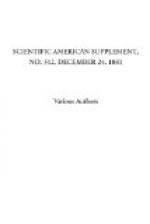I have already shown that in what we term combustion not a particle of the ponderable matter is annihilated. Combustion is but a phenomenon resulting from a rearrangement of the particles, and so it is with the imponderable physical force caloric; it is not consumed when light and heat are produced, nor converted into power, as we are sometimes told. But whatever the phenomena produced, the aggregate amount of static and dynamic caloric is always and ever the same.
If we consider the Ritter-Plant-Faure-Battery, which is mentioned as storing electricity, we find that the phenomena exhibited by the use of this apparatus are produced by the same factor. The battery is composed of two sheets of lead, which are covered with a layer of minium (Pb3O4). The sheets are laid one upon the other with an intervening layer of felt. The pack is then rolled up in a spiral form and placed in a vessel containing acidulated water. One of the plates is connected with the positive, and the other plate with the negative pole of a battery or generator.
When the current of electricity enters the battery, the Pb3O4 on the positive plate is reduced to Pb, and the oxygen so set free attacks the Pb3O4 on the negative plate, and oxidizes it to PbO2. In this chemical action, caloric is occluded in the Pb and unlocked in the PbO2, but a much greater amount of caloric is locked up than is unlocked, although the amount of oxygen used in both cases is precisely the same, which has been fully explained in the oxidation of carbon.
Now after the battery has been thus charged and the wires disengaged, the chemical action ceases for want of the reducing agent (dynamic caloric), and the apparatus may be held at rest, or transported to any distance required. When it is desired to utilize the force thus stored, the poles are changed by grounding the positive wire, and attaching the other to the conduit through which the electricity is to flow. The chemical action is thus reversed, and the PbO2 is reduced to Pb3O4, the oxygen thus set free attacks the Pb on the other plate, oxidizing it to Pb3O4, thus unlocking all the caloric which was occluded by the first action. In a battery of this kind weighing 75 pounds, we are informed by Sir William Thomson, that one million foot pounds of force may be stored, and again set free for use.
Thus we find that the principle upon which the Faure battery is formed is not new, and the prime factor producing the phenomena is the same as has been shown to have caused all other phenomena referred to, and indeed the principle is the same as now employed by the author in the basic dephosphorizing process, i.e., caloric is occluded in phosphorus by smelting in a blast furnace, and unlocked in the converter, for the purpose of securing the fluidity of the metal during treatment. The difference being, that one is done by non-luminous, while the other is by luminous combustion.
If we consider the phenomenon of light, we find that it is due to the same force. As before stated, when we oxidize carbon, or hydrogen, as in the rapid combustion of wood, oil, or coal, the escaping caloric flies off with such great speed as to cause the molecules in the circumambient medium to assume a velocity which exhibits luminosity. Thus the light produced by burning candles, oil, gas, wood, and coal, is caused by the same prime factor, dynamic caloric.




